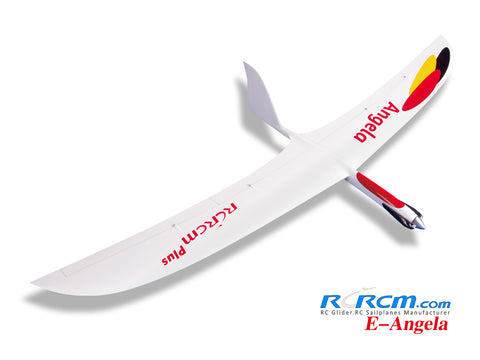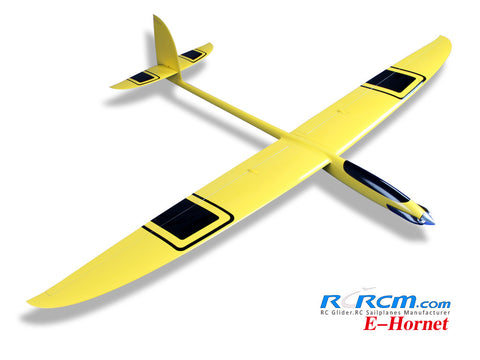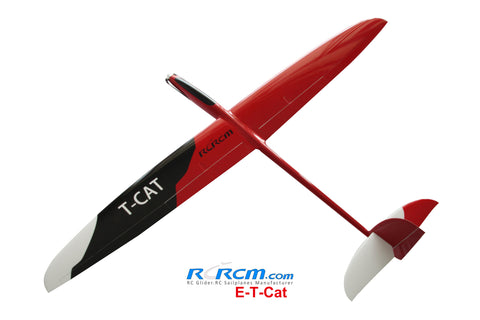DESCRIPTION:
RCRCM 2000mm Wingspan all rounder slope Racer – TYPHOON
Typhoon offers outstanding performance and excellent thermal flight qualities. The flight of the Typhoon is highly agile and maneuverable, it will go where you like in a dream. It is able to fly in virtually all conditions and it is equipped with ailerons, a drift, depth and the electric version of an engine. Typhoon can of course perform aerobatic maneuvers or turn into a real rocket! You can slow down for a landing or to the catch by hand.
Aimed at the flyer who has made his bones on smaller ships and now wants something with higher potential, the Typhoon offers sparkling slope performance, but turns into a pussycat when thermal. For experienced flyers, the plane handles like a dream, has no vices and yet is capable of amazing performance in the right hands.
Able to fly in almost any conditions and equipped with a full house complement of ailerons, rudder, elevator and flaps, the Typhoon can perform leisurely aerobatics or be made into a hair-raising, jaw-aching rocket by the addition of ballast, yet it will slow down to hand-catch speed for landings. Made from CNC generated moulds, and supplied with a full kit of small parts and a massive 20mm ballast tube, Typhoon is constructed to the highest standards of fit and finish.
Available in 4 Versions:
Fiberglass+Carbon Standard Version: Standard hollow molded fiberglass construction reinforced with carbon fiber which gives good stiffness and torsion stability with lower weight and cost. Highly recommended for sport flying.
Carbon Version: Wings built using carbon cloth as well as fuselage reinforced with carbon from leading edge of the wing to the tail. This configuration gives the model enormous stiffness and torsion stability.
The first two versions are available in stock. We also can produce two custom versions; Light Carbon Version (less weight) and Double Carbon Version (with two layers of carbon).
Features:
- Able to fly in almost any conditions and equipped with a full house complement of ailerons, rudder, elevator and flaps.
- Typhoon can perform leisurely aerobatics or be made into a hair-raising, jaw-aching rocket by the addition of ballast, yet it will slow down to hand-catch speed for landings.
- Control Surfaces: Rudder, Elevator, Ailerons and Flaps
- Two-piece hollow molded composite Carbon Fiber or Glass wing design
- Carbon Fiber reinforced wing with square wing joiner
- Live hinges on the wing and rudder with pre-installed wipers
- Smooth, gel-coated finish with pre-painted graphics
- Full flying stabilizer with pre-installed bellcrank
Includes:
- 2000mm Wingspan Glider – TYPHOON
- Ballast Tube(for Motorless Glider only), Motor mount(for electric version only), Servo tray, Push Rod, Clevis, Linkage Rod, Control horn, Servo Cover, Wing joiner, tail joiner, servo plate
SPECIFICATIONS:
Preferences MOTOR
Wingspan: 2000mm
Length: 1200mm
Wing area: 32dm2
Flying Weight: N/A
Empty Weight: Fiberglass+Carbon Standard Version:900g
Carbon Version: 960g
CG: 82 mm from leading edge
Tow hook setting NO
Ailerons YES
Elevator YES
Rudder YES
Flaps YES
Required Radio No less than 7 channels
Recommend equipment configuration for an electric version Basic configuration
Servos for wings KST DS135MG*4
Servos for fuselage KST DS215MG*2
Required Battery 3S 11.1V 2200mah 25c
Power System Neu 1110/1Y w/6.7:1
Motor Mount Dia. 38mm
Electronic Speed Control SkyWalker-60A
Fairing size 38mm
Propeller/EDF 11*6
Paint Scheme is also available in a wide range of colors, besides standard color scheme presents on this website and can also include some other color schemes.
Another important thing about the surface of the glider: this RCRCM glider is fully moulded. Mould precision ensures that each glider has a complete aerodynamic layout but in the process of composite production, there is a slight chance of very tiny air bubbles or slight cloth grain. In the unlikely event that these small imperfections exist, they do not affect the structural strength or flight performance.
Glider long term storage: Hang glider vertically to reduce the stress on the glider surfaces to avoid deformation that could adversely affect flight performance and trim.







































